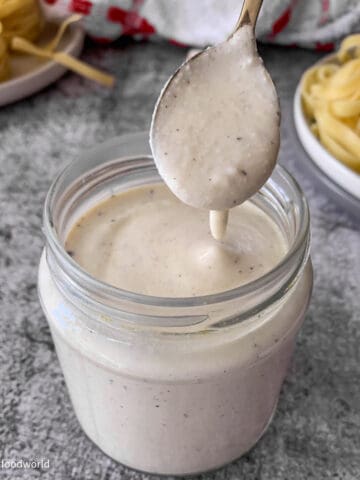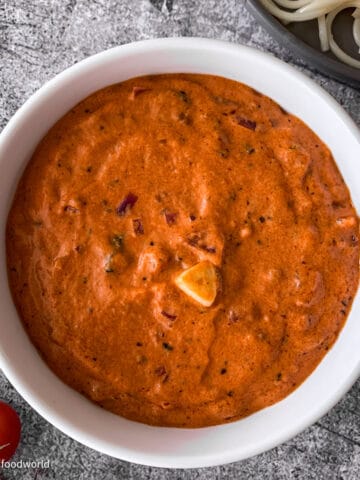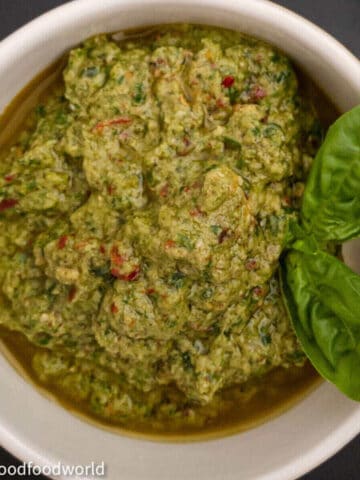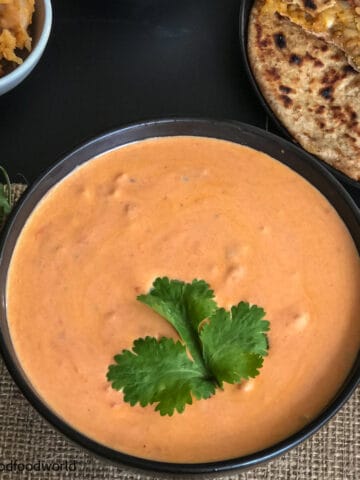This Indian tamarind sauce recipe, also known as imli chutney, is plant-based, soy-free, and gluten-free. Made with all-natural ingredients, this tangy, spicy, and sweet sauce is versatile - it serves as a dipping sauce, garnish, or glaze.
The other day, I tried a twist on traditional chaat with chickpea patties and potato curry. It was a delicious reverse chaat experience! Typically, chaat is made with aloo tikki (potato patties) that are topped with chickpea curry, made either with regular or brown chickpeas, and topped with onions, green chutney, yogurt, and tamarind sauce. So, I flipped the script: chickpea patties served with potato curry and all the fixings. It was a hit! 😍
Although imli chutney (imli means tamarind in Hindi) is a staple drizzle for Indian street foods, it's also a versatile dipping sauce. I enjoy it with everything from veggie sticks to naan, pakoras, french fries, and even nachos. Check out the serving suggestions below for more creative ideas.
The sweet-tangy flavor of this tamarind sauce recipe makes it an excellent glaze, especially for roast veggies and paneer. A friend of mine even used it to glaze her chicken wings, and they were a hit!
This post contains helpful notes and tips to help you make the perfect dish. However, if you are in a rush, please use the "Jump to Recipe" link above or the "Jump to" links below to get to the section you want.
Jump to:
Allergens free labels
This sweet tamarind sauce is naturally plant-based, gluten-free, and free of alliums. It is also free of:
- grains
- nuts
- soy
- dairy
Additionally, this recipe contains no added oil or tomatoes, making it suitable for those with various dietary restrictions.
Disclaimer: Our content aims to be informative and educational, but it should not replace professional medical advice. Since manufacturing processes can vary and cross-contamination is possible, it's essential to verify product labels and allergen information. Make sure all ingredients align with your specific allergies. As readers, you bear the responsibility for ensuring allergen safety when buying or consuming foods.
Recipe Overview

This dish goes by several names: imli chutney, khatta meetha chutney (where "khatta" means tangy and "meetha" means sweet), sweet tamarind sauce, sweet tamarind chutney, or simply tamarind chutney. Throughout this post, I'll be using these terms interchangeably.
It's a common condiment in Indian cuisine, often accompanying chaat - Indian street food. There are numerous variations of this sauce. Over the years, I've experimented with many versions and finally settled on this recipe for its ease, healthiness, and deliciousness!
I prepare my tamarind sauce in the Indian style, so it doesn't include soy sauce commonly found in Thai recipes. Instead, it features tamarind, jaggery, dates, and Indian spices.
Ease: This sauce comes together in about 1 hour, with most of the process being hands-off. This allows me to multitask, like making veggie muffins that pair wonderfully with this chutney.
You can use tamarind concentrate or tamarind pulp for this sauce, but I prefer making it from scratch with blocks of tamarind.
Texture and consistency: The sauce is smooth with a delightful crunch from the cumin seeds, and it boasts a thick, almost jammy consistency. Boiling it until thickened extends its shelf life, so don't hesitate to make a large batch. When serving it as a dipping sauce or filling for pani puri, I adjust the consistency by adding water.
Equipment: I recommend using a kitchen scale for precision since ingredients like dates and jaggery are challenging to measure in cups and spoons. A high-speed blender is also handy for creating a smooth puree and reducing the effort needed for sieving.
What is the flavour of tamarind sauce?
The flavor of this tamarind sauce is a delightful blend of sweet, tangy, and subtly spicy.
As I've mentioned in my article on souring agents, tamarind is the fruit of the tamarind tree and has a sour taste. In this recipe, the sourness of tamarind is balanced by the sweetness of jaggery and dates. I use minimal spices to gently enhance the sauce's flavor and maintain balance.

What is a tamarind sauce made of?
The star of the tamarind sauce recipe is, as you've probably guessed , tamarind.
Here's a quick overview of the ingredients. As always, refer to the recipe card for quantities and detailed instructions.

- Tamarind: I've opted for pitted and cleaned fruit, typically found in Asian grocery stores as a block wrapped in plastic. If you're using whole tamarind pods, remember to peel them and remove the seeds and fibers. Just a heads-up, it adds a bit more time and effort.
- Jaggery (also known as “gud”): This unrefined sugar, derived from cane or palm, imparts its unique sweetness to the recipe. If jaggery isn't available, dark brown sugar or muscovado make good substitutes.
- Dates: Opt for soft, fresh, good-quality ones. For this chutney, we specifically need pitted dates. The quantity mentioned in the recipe refers to pitted dates.
- Roasted cumin powder (bhuna jeera): This spice adds a deep, earthy aroma to the sauce. If you don't have it, a blend of regular cumin seeds and ground cumin can be used.
- Ground ginger (dry ginger powder): This is fresh ginger that has been dried and finely ground into powder. You can easily find it in any Indian grocery store. If you don't have it, use chaat masala instead.
- Red chili powder: To balance the sweet and sour flavors, I've opted for cayenne pepper powder. Feel free to adjust the heat by selecting milder or spicier chili powder according to your preference. Alternatively, you can omit it altogether.
Have a question regarding the ingredients? Feel free to ask in the comments section below and I will try my best to answer it for you.
Instructions
Making this easy tamarind chutney sauce takes about an hour in total. But as mentioned earlier, most of the process is hands-off, giving you time to do other things.
The recipe card below provides detailed instructions and quantities. Also, check out the video at the end of the recipe card.
Step 1: Soak the tamarind and dates. Chop the dates into 2-3 pieces each. Remove any stringy bits from the tamarind and soak them in hot (just boiled) water for 30 minutes.
Workflow tip: While the tamarind and dates are soaking, whip up this simple onion chutney to accompany your cheese board (more on that later).

Step 2: Make the puree and sieve it. Grind the soaked dates and tamarind, along with the water they've been soaking in, to a smooth puree.
Place the sieve over the saucepan in which you'll make the sauce, then pour the puree into it. Use the back of a spoon to strain the puree, ensuring only the smooth pulp flows into the saucepan.

Step 3: Make the sauce. Add the jaggery, water, and the spices to the puree.

Place the saucepan on the stove and allow the tamarind mixture to come to a boil over medium heat. When it reaches a rolling boil, reduce the heat to medium and let it simmer for 30-35 minutes, or until the jaggery has melted, the tamarind has cooked, and the sauce has thickened.
Workflow tip: While the sauce is simmering, whip up this amla pudina chutney to serve as another dip.
Stir the sauce occasionally. It will thicken as it cooks and darken in color, resembling more like a syrup.
To check if the sauce is done, dip a spoon into it and run your finger along the back of the spoon. If your finger leaves a clean line that stays, the sauce is ready.
Be cautious when running your finger along the mixing spoon as it will be very hot.

And that's it! Your rich, smooth, and glossy tamarind sauce is ready! See the section below for storage and pairing suggestions.
Notes and Substitutions
As mentioned earlier, I've experimented with many versions of this sauce - adjusting the quantity of jaggery and dates, trying it without dates, incorporating other Indian spices, and even using my own tamarind paste - whew! After many trials, I've settled on this version.
There are no strict rules for this recipe, so feel free to make it your own. If you prefer a sour tamarind sauce, reduce the amount of jaggery. Add more spices like fennel seeds, coriander powder, or asafoetida (hing) if you enjoy those flavors - until you achieve your perfect tamarind sauce. Whatever changes you make, yours will undoubtedly taste better than any store-bought tamarind sauces!
Here are some insights from my experiences:
Cooking tamarind well brings out the best flavors - rich, deep, and fruity undertones.
Thick vs. thin sauce: I prefer it thick, as it can always be thinned later. Cooking until thick also extends the sauce's shelf life. For a thinner sauce, you can either A) reduce the cooking time to about 20 minutes, or B) add warm water later.
Yield: This recipe yields about 1 and a half cups (300g) of sauce.
Jaggery: This ingredient is a staple in our household and I use it in many dishes, such as this bitter gourd recipe and this calabash stew. I buy a block of it and break it into chunks at home. To save yourself the effort, you can buy jaggery powder instead, which is readily available in any Indian supermarket.
Substitutions / Swaps: I mentioned these earlier in the post and am summarizing them here for you:
- No jaggery? Swap it with dark brown sugar or muscovado.
- Red chili powder: Choose a variety as spicy or mild as you prefer, or omit it and increase the quantity of black pepper powder.
- Roasted cumin powder: Substitute with a mixture of whole cumin seeds and ground cumin.
Any doubts or questions? Feel free to ask via the comments below. I will try my best to answer them for you. - Padma

Storage and serving suggestions
Traditionally and most commonly, this khatta meetha chutney is drizzled over aloo chaat, dahi vadas, kebabs, and paneer tikkas. It's an essential ingredient in the water for pani puris. Alongside green chutney, yogurt mint sauce, and spicy red garlic chutney, this imli chutney is served as a dip with samosas, pakoras, and onion bhajis.
Here are some modern, unique ways to enjoy this Indian tamarind sauce:
- spread it on toast as your jam.
- include it on a cheese board with spicy onion chutney, green chutney, and a yogurt mint sauce.
- use it as a glaze or marinade.
- drizzle it over your burger patty or sandwich filling.
This is such a versatile sauce! I would love to hear how you have included it in your meals. Do let me know via the comments below. - Padma.
Storage: Allow the sauce to cool completely, then transfer it to a fridge-safe, preferably glass, jar with a tight-fitting lid. Alternatively, store it in any airtight container in the fridge. This sauce will keep for 2-3 weeks.
When serving, use a clean, dry spoon. To make a thinner sauce, place the desired amount of sauce in a bowl, add warm water, and mix well.
This sauce freezes well. Store it in ice-cube trays or small freezer-safe bags for up to 4 months. Once thawed, do not freeze again.
Frequently Asked Questions
Tamarind has a sweet-tangy, almost date-like taste that complements a variety of dishes. Its tangy flavor enhances both savory and sweet recipes alike. From traditional Indian curries to refreshing drinks, tamarind is a versatile ingredient.
Tamarind gives a unique tangy-sweet flavor to dishes, with rich, fruity undertones that enhance savory sauces, marinades, and desserts, adding depth and complexity to the dish.
Making tamarind sauce is easy, and most of the process is hands-off!
To make it, soak tamarind and dates in hot water and then grind them to a smooth puree. Pass the pulp through a sieve and then simmer it with water, jaggery, and spices until thickened. Voila! You've got a tangy, flavorful sauce perfect for dipping, drizzling, or marinating your favorite dishes.
Tamarind sauce lasts about 2-3 weeks in the fridge. Store it in an airtight container for optimal freshness. It can also be frozen for up to 4 months. Enjoy its tangy goodness with snacks, meals, or as a flavorful marinade.
If you like this recipe, please take a moment to leave a comment and a rating below. This will motivate me to create more good content for you! You can also engage with me on Twitter, Facebook, and Instagram. - Padma
📖 Recipe

Tamarind Sauce Recipe (Imli Chutney): Sweet & Spicy
Equipment
- 1 large bowl, for soaking
- 1 mixing spoon
- 1 mixer-grinder
- 1 sieve
- 1 saucepan
- 1 bottle, preferably glass, to store the sauce
- 1 kitchen weighing scale
Ingredients
- 1 and ¾ oz. (~50g) pitted dates
- ½ oz. (~28g) tamarind, seeds and fiber removed
- 5 and ¼ oz. (~150g) jaggery , see notes
- 1 and ¼ cups (~300ml) water
Spices
- ½ teaspoon red chili powder
- ½ teaspoon bhuna jeera, see notes
- ¼ teaspoon salt
- ¼ teaspoon ground ginger , dry ginger powder, see notes
- ¼ teaspoon black pepper powder
Instructions
Prepare the Ingredients
- Remove any stringy bits from the tamarind.
- Cut the dates into 2-3 pieces each.
- In a saucepan or kettle, bring ¾ cup (200 ml) of water to a boil. Set aside the remaining water for later use.
- Measure the rest of the ingredients.
Soak the dates and tamarind
- Place the tamarind and dates in a large bowl and pour the hot water over them. Let them soak for 30 minutes.1 and ¾ oz. (~50g) pitted dates, ½ oz. (~28g) tamarind
Make the sauce
- Grind the soaked dates and tamarind along with the water to a smooth puree.
- Place the sieve over the saucepan in which you will be making the sauce. Tip the puree into the sieve and, with the help of a spoon, sieve the puree into the saucepan. Discard the fibrous remains.
- To the sieved pulp, add the remaining 100 ml (approximately ¼ cup) of water, jaggery, and spices.5 and ¼ oz. (~150g) jaggery, 1 and ¼ cups (~300ml) water, ½ teaspoon red chili powder, ½ teaspoon bhuna jeera, ¼ teaspoon salt, ¼ teaspoon ground ginger, ¼ teaspoon black pepper powder
- Place the saucepan on the hob and allow the mixture to come to a boil over medium-high heat.
- When the mixture reaches a lively boil, turn the heat down to medium and let it cook for 30-35 minutes or until the sauce has thickened and darkened in color.
- Stir the sauce occasionally. To check if the sauce is done, dip a spoon into the sauce and run your finger along the back of the spoon. If your finger makes a clean line that stays, the sauce is ready.Be careful when running your finger on the mixing spoon as it will be very hot.
- Allow the sauce to cool down completely and then transfer it to a clean, glass jar with a tight-fitting lid. Store it in the fridge.
Video
Notes
Alternative quantities provided in the recipe card are for 1x only.
Allergens Disclaimer
Our content aims to be informative and educational, but it should not replace professional medical advice. Since manufacturing processes can vary and cross-contamination is possible, it's essential to verify product labels and allergen information. Make sure all ingredients align with your specific allergies. As readers, you bear the responsibility for ensuring allergen safety when buying or consuming foods.
Disclosure: The nutritional information is calculated using an online calculator and is based on available ingredients and preparation. It should not be considered a substitute for a professional nutritionists' advice. Changing the quantities and cooking technique will alter the nutritional calculations.





Faoz says
I love how you used simple and all-natural ingredients to make the sauce, this recipe is a great substitution for store-bought sauces💚
Padma Kumar says
Thank you Faoz, this is definitely way better that those store bought ones.